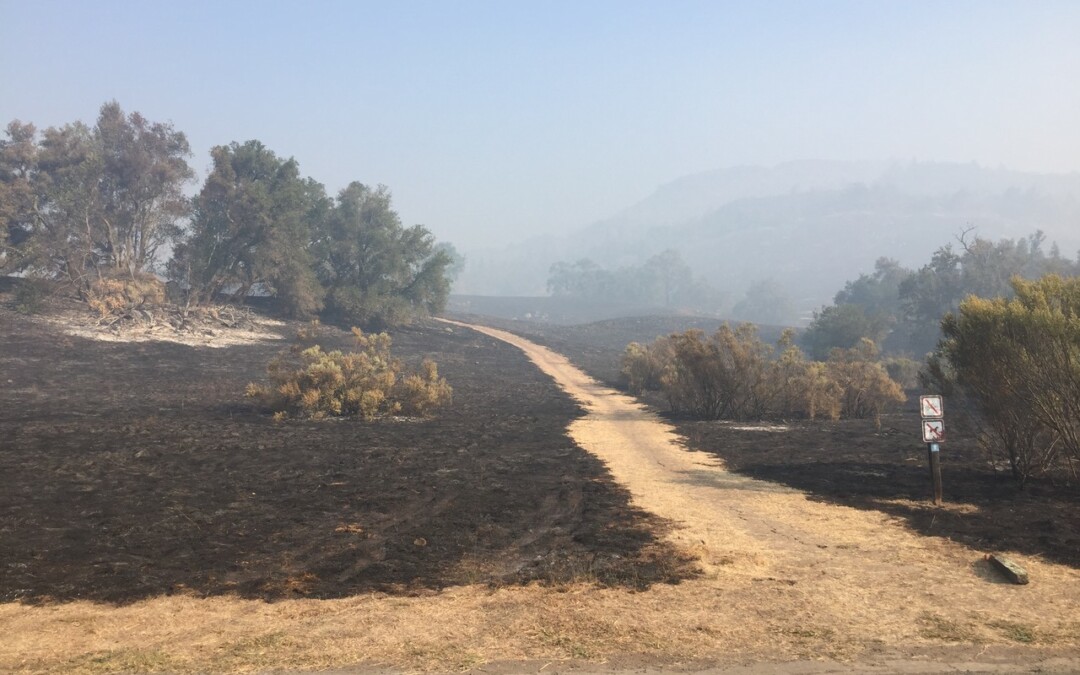UPDATE: For more complete tips and information, please see our new Sonoma Valley Fire Recovery page.
Wildfires swept through more than a quarter of Sonoma Valley in October 2017. Many returning residents want to expedite the healing of their land but aren’t sure how to go about it.
The most important rule is to be safe. Assess the property carefully before acting. Watch out for potential hazards. Consult with professionals as appropriate.
Remember that the land has burned frequently over thousands of years. The native plants and animals are adapted to recover from fire. Be patient. Anticipate the wildflowers next spring!
Don’t
- Do not enter the area where a building has burned, or handle the ashes of a burned building, without prior testing and protective gear: proper clothing, respirator, eye protection, gloves, etc. Vegetation ash is not toxic, but ash and debris from man-made materials may contain asbestos, heavy metals, or other hazardous substances. Do not touch or breathe this material without consulting with county officials.
- Do not re-seed a large burned site, not even with “native” seeds. Fire releases the native seeds stored in the soil, and those seeds will restore the land. Most grasses found in seed mixes are short-lived, and will be highly flammable by next summer. In addition, a sudden flush of grass can attract pests. Many “native” or “wildflower” seed mixes contain species that are genetically inappropriate to our area and could be destructive invaders.
- Do not spread straw or hay, or use bales, unless you can find certified weed-free material, or rice straw. Even material sold as weed-free is often contaminated.
- Do not simply chip or remove all brush, branches, and trees. Rather, use that material to prevent soil erosion (see below).
Do
- Be cautious! Before re-entering a burned site, assess the property for hazards including toxic ash and debris, unstable structures, trees with burnt trunks, power lines, and landslides or mudslides.
- Consult with county officials and obtain professional help in removing potentially toxic materials. Ideally, clean the site before rains wash toxic runoff into storm drains and waterways. Slow down soil movement, especially into waterways. Use fallen branches, small berms, sandbags, check dams, silt fencing, native plants or other features to slow runoff into creeks. Repair fire breaks so they do not channel runoff but blend evenly with the slope of the land. Mulching is only modestly effective for reducing erosion, and can introduce weeds. Use only mulch with seed-free material, such as chipper material from a known source, hydromulch without seed, certified weed-free straw, or rice straw.
- Have an ecologist or arborist assess the damage to vegetation before planting or seeding broadly. Most trees and shrubs will recover on their own, and the land’s existing seed bank will push new growth in the winter. If you do seed, use only locally native perennial species. Exception: in highly managed areas, such as areas that are kept mown, it’s OK to use short-lived plants like those found in most seed mixes.
- Be suspicious of “weed-free” material for sale. Inspect it carefully yourself. Supplies are limited.
- Be patient. These lands have recovered from wildfires countless times before. In most cases, once man-made debris and ash are removed from a burn site, the land will heal itself – it just needs time.
Click here for pdf version of Post-Fire Tips
Note: Information on this page is being updated as needed. Tips may not apply to all sites. Information sources include Sonoma Ecology Center, North Bay Climate Adaptation Initiative, www.laspilitas.com/fire.htm, and www.sonomacounty.ca.gov.

